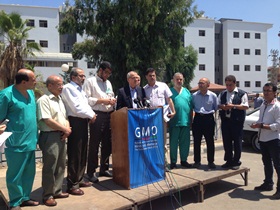WHO-World Bank: tracking universal health coverage; 2017 global monitoring report
Key messages
Universal health coverage means that all people can obtain the health services they need without suffering financial hardship. This report looks at how many people globally lack access to essential health services and how many are pushed into poverty or spending too much of their household budgets on health care expenses.
The data show that despite some progress, there is a long way to go to get to universal health coverage by 2030: the global target agreed to under the Sustainable Development Goals (SDGs). Failure to accelerate progress towards universal health coverage not only means that SDG 3 (on better health for all) is out of reach, it also puts the overarching global goal of ending poverty (SDG 1) out of reach because health care is a key reason why people globally are pushed into poverty.
Service coverage
Not all countries have the means to ensure coverage of all health services, but all countries should be able to ensure coverage of a core set of “essential” health services, regardless of their demographic, epidemiological or economic profile. These services relate to needs encountered across the life course, and to reproductive, maternal, neonatal and child health, infectious diseases, noncommunicable diseases, and injuries.
At the same time, countries should ensure that no one is left behind: all population groups within a country, including the most disadvantaged, should be able to access the quality health services they need.
Services received should be of sufficient quality to realize potential health gains. For example, a person living with hypertension should not only receive treatment, but this treatment should be of sufficient quality to ensure that their blood pressure levels are reduced to normal levels.
Essential health services
At least half of the world’s population still do not have full coverage of essential health services. Although they may have access to some health services, more than half of the world’s more than 7.3 billion people do not receive all of the essential services they need.
Considering the coverage gap for some specific services:
- More than 1 billion people live with uncontrolled hypertension;
- More than 200 million women are inadequately covered for family planning;
- Nearly 20 million infants do not receive the immunizations they need to protect them from diphtheria, tetanus and pertussis, with many more missing other recommended vaccines.
This estimate does not include financial protection i.e. whether people experienced financial hardship as a result of paying for health services, but solely whether the essential health services themselves are accessible and used.
Levels of health service coverage vary widely across regions and countries
In order to paint a picture of progress in countries towards the SDG target on service coverage for universal health coverage, an index ranging from 0 to 100 has been developed. The index is based on a number of tracer indicators that represent the basket of essential services that should be provided as part of universal health coverage. This index shows that coverage of essential services is poorest in Sub-Saharan Africa, followed by Southern Asia. It is highest in East Asia, Northern America and Europe.
Within many countries there are large inequalities in service coverage among sub-populations. Health service coverage varies not just between countries but also within countries. National averages can mask low coverage levels in disadvantaged population groups.
Data on inequalities are most available for maternal and child health services. In low- and lower-middle income countries, maternal and child health services are seriously impacted by inequalities within countries.
- Only 17% of mothers and children in the poorest fifth of households in low and lower-middle income countries received at least 6 of 7 basic maternal and child health interventions compared to 74% for the wealthiest fifth of households.
- 9% of mothers and children in the poorest fifth of households did not receive any of the 7 basic interventions.
- Progress has been made in access to a number of essential health services required for universal health coverage.
The most rapid rates of increase were seen in coverage of antiretroviral treatment for HIV (2% in 2000 to 53% in 2016) and use of insecticide treated nets for malaria prevention (1% to 54% in 2016). Other positive trends include:
- demand for family planning satisfied with modern methods has increased from 75% to 78% in 2016;
- TB effective treatment has increased from 23% to 50% in 2016;
- basic sanitation has increased from 59% to 68% in 2015.
Financial protection
When families have to pay for health care expenses out-of-pocket for a sick child or other family member, this puts a major strain on their household budget. In too many instances, out-of-pocket health expenditures are “impoverishing” – i.e. pushing people below the poverty line or pushing those who are already poor further into poverty. This makes resolving the issue of health care expenditures, and sustainable and equitable financing of health systems, doubly important – not only to ensure better health, and but also to ensure less poverty and greater equity.
About 100 million people are still being pushed into “extreme poverty” (living on US$ 1.90 or less a day) because they have to pay for health care. This number has shown improvement, and has fallen from around 131 million people in 2000 being pushed into extreme poverty.
However, in addition to this, more than 122 million people around the world were pushed below the US$ 3.10-a-day poverty line, and are now officially classified as “poor,” due to health care expenditures. This population has increased by 1.5% per year.
Increasing numbers of people globally are incurring “catastrophic expenditures” on health care.
This means they are spending at least 10% of their household budgets on out-of-pocket health expenses. At this level of expense, families often have to choose between health care and other necessities for their household, like food or school fees.
- Over 800 million people (almost 12% of the world’s population) spent at least 10% of their household budgets to pay for health care. This population has grown by over 3% per year globally.
- Even worse, almost 180 million people within this population spent a quarter or more of their household budgets on out-of-pocket health expenses. This population has increased even faster, by almost 5% a year.
- Incurring catastrophic expenses for health care is a global problem, not just an issue in “poor countries.” Even in Europe, Latin America and parts of Asia, which have achieved high levels of access to health services, increasing numbers of people are spending at least 10% of their household budgets on out-of-pocket health expenses.
WHO-World Bank: tracking universal health coverage: 2017 global monitoring report
Key messages
Universal health coverage (UHC) means that all people can obtain the health services they need without suffering financial hardship. This report looks at how many people globally lack access to essential health services and how many are pushed into poverty or spending too much of their household budgets on health care expenses.
The data show that despite some progress, there is a long way to go to get to UHC by 2030: the global target agreed to under the Sustainable Development Goals (SDGs). Failure to accelerate progress towards UHC not only means that SDG3 (on better health for all) is out of reach, it also puts the overarching global goal of ending poverty (SDG1) out of reach because health care is a key reason why people globally are pushed into poverty.
Service coverage
Not all countries have the means to ensure coverage of all health services, but all countries should be able to ensure coverage of a core set of “essential” health services - regardless of their demographic, epidemiological or economic profile. These services relate to needs encountered across the life course, and to reproductive, maternal, neonatal and child health, infectious diseases, noncommunicable diseases, and injuries.
At the same time, countries should ensure that no one is left behind: all population groups within a country, including the most disadvantaged, should be able to access the quality health services they need.
Services received should be of sufficient quality to realize potential health gains. For example, a person living with hypertension should not only receive treatment, but this treatment should be of sufficient quality to ensure that their blood pressure levels are reduced to normal levels.
Essential health services
At least half of the world’s population still do not have full coverage of essential health services
• Although they may have access to some health services, more than half of the world’s more than 7.3 billion people do not receive all of the essential services they need.
• Considering the coverage gap for some specific services:
o More than 1 billion people live with uncontrolled hypertension;
o More than 200 million women are inadequately covered for family planning;
o Nearly 20 million infants do not receive the immunizations they need to protect them from diphtheria, tetanus and pertussis, with many more missing other recommended vaccines.
• This estimate does not include financial protection i.e. whether people experienced financial hardship as a result of paying for health services, but solely whether the essential health services themselves are accessible and used.
Levels of health service coverage vary widely across regions and countries
• In order to paint a picture of progress in countries towards the SDG target on service coverage for UHC, an index ranging from 0 to 100 has been developed. The index is based on a number of tracer indicators that represent the basket of essential services that should be provided as part of UHC.
• This index shows that coverage of essential services is poorest in Sub-Saharan Africa, followed by Southern Asia. It is highest in East Asia, Northern America and Europe.
Within many countries there are large inequalities in service coverage among sub-populations
• Health service coverage varies not just between countries but also within countries. National averages can mask low coverage levels in disadvantaged population groups.
• Data on inequalities are most available for maternal and child health services.
• In low- and lower-middle income countries, maternal and child health services are seriously impacted by inequalities within countries.
o Only 17% of mothers and children in the poorest fifth of households in low and lower-middle income countries received at least six of seven basic maternal and child health interventions compared to 74% for the wealthiest fifth of households.
o 9% of mothers and children in the poorest fifth of households did not receive any of the seven basic interventions
o
Progress has been made in access to a number of essential health services required for UHC
• The most rapid rates of increase were seen in coverage of antiretroviral treatment for HIV (2% in 2000 to 53% in 2016) and use of insecticide treated nets for malaria prevention (1% to 54% in 2016). Other positive trends include:
o Demand for family planning satisfied with modern methods has increased from 75% to 78% in 2016.
o TB effective treatment has increased from 23% to 50% in 2016.
o Basic sanitation has increased from 59% to 68% in 2015.
Financial protection
When families have to pay for health care expenses out-of-pocket for a sick child or other family member, this puts a major strain on their household budget. In too many instances, out-of-pocket health expenditures are “impoverishing” – i.e. pushing people below the poverty line or pushing those who are already poor further into poverty. This makes resolving the issue of health care expenditures, and sustainable and equitable financing of health systems, doubly important--not only to ensure better health, and but also to ensure less poverty and greater equity.
About 100 million people are still being pushed into “extreme poverty” (living on $1.90 or less a day) because they have to pay for health care. This number has shown improvement, and has fallen from around 131 million people in 2000 being pushed into extreme poverty.
• However, in addition to this, more than 122 million people around the world were pushed below the $3.10-a-day poverty line, and are now officially classified as “poor,” due to health care expenditures. This population has increased by 1.5 percent per year.
Increasing numbers of people globally are incurring “catastrophic expenditures” on health care.
This means they are spending at least 10 percent of their household budgets on out-of-pocket health expenses. At this level of expense, families often have to choose between health care and other necessities for their household, like food or school fees.
• Over 800 million people (almost 12 percent of the world’s population) spent at least 10 percent of their household budgets to pay for health care. This population has grown by over 3 percent per year globally.
• Even worse, almost 180 million people within this population spent a quarter or more of their household budgets on out-of-pocket health expenses. This population has increased even faster, by almost 5 percent a year.
• Incurring catastrophic expenses for health care is a global problem, not just an issue in “poor countries.” Even in Europe, Latin America and parts of Asia, which have achieved high levels of access to health services, increasing numbers of people are spending at least 10 percent of their household budgets on out-of-pocket health expenses.
WHO Regional Director Dr Ala Alwan visits Gaza
 Dr Alwan met with the Palestinian President Mahmoud Abbas and the Palestinian Minister of Health Dr Jawad Awwad and discussed with them the support required from WHO to address their health needs. UNRWA’s Director of Health Dr Akihiro Seita joined the Regional Director on his visit.
Dr Alwan met with the Palestinian President Mahmoud Abbas and the Palestinian Minister of Health Dr Jawad Awwad and discussed with them the support required from WHO to address their health needs. UNRWA’s Director of Health Dr Akihiro Seita joined the Regional Director on his visit.
 Dr Alwan visited three hospitals that have been damaged and are no longer functioning.
Dr Alwan visited three hospitals that have been damaged and are no longer functioning.
 He held a press conference to highlight the health challenges that need to be addressed immediately, including the referral of patients to hospitals outside of Gaza for life-saving treatment.
He held a press conference to highlight the health challenges that need to be addressed immediately, including the referral of patients to hospitals outside of Gaza for life-saving treatment.
 Dr Alwan also visited an UNRWA health clinic in northern Gaza that has been closed and he visited Gaza’s main hospital, Al Shifa, meeting with casualty patients, health workers and the hospital director who described how the hospital staff had managed to treat the many casualties it received under exceptionally difficult conditions. Dr Alwan spoke with patients and health workers at Mohammed Al Durrah Pediatric Hospital in which 30 people were injured on 24 July.
Dr Alwan also visited an UNRWA health clinic in northern Gaza that has been closed and he visited Gaza’s main hospital, Al Shifa, meeting with casualty patients, health workers and the hospital director who described how the hospital staff had managed to treat the many casualties it received under exceptionally difficult conditions. Dr Alwan spoke with patients and health workers at Mohammed Al Durrah Pediatric Hospital in which 30 people were injured on 24 July.
 To date, WHO has sent a total of US$ 2.5 million in medical supplies and medicines to support the needs of hospitals and clinics in Gaza.
To date, WHO has sent a total of US$ 2.5 million in medical supplies and medicines to support the needs of hospitals and clinics in Gaza.


